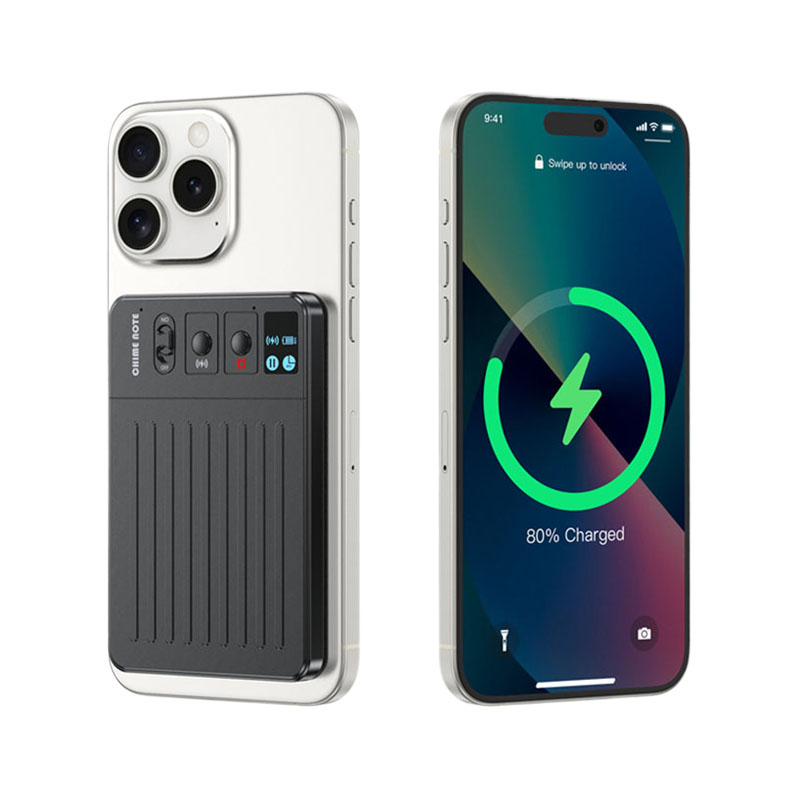How effective is ai voice recorder at voice separation in noisy environments?
Release Time : 2025-10-29
In noisy environments, the AI Voice Recorder's voice separation performance has become a key indicator of its core competitiveness. Traditional recording equipment often faces the "cocktail party problem" in complex sound fields—difficulty accurately extracting the target human voice from a mix of noise, such as keyboard clatter, air conditioning, and crowd chatter. AI technology, through deep learning and acoustic modeling, offers a breakthrough solution to this problem. Its core principle is to build an acoustic feature library. By analyzing tens of thousands of real-world noise samples (such as keyboard tapping, traffic noise, and appliance hum), the model is trained to identify the spectral differences between the human voice and interfering sounds, enabling precise separation. This process relies not only on the hardware's sound pickup capabilities but also on algorithms that infer the sound propagation path. For example, by analyzing the sound's reflection patterns within the room to locate the sound source and filter out the target speaker's voice signal.
The AI Voice Recorder's voice separation performance has been significantly enhanced at the hardware level. For example, some high-end models utilize a combination of directional and omnidirectional microphones, using beamforming technology to focus on sound sources in a specific direction while suppressing noise from other directions. For example, a certain brand of voice recorder features an 8-microphone ring array that dynamically adjusts the sensitivity of each microphone, creating a virtual "sound isolation shield." Even in extremely noisy environments like airports and trade shows, it can clearly capture the voice of speakers within 5 meters. Furthermore, the addition of a hardware noise reduction chip further improves processing efficiency. The DSP dynamic noise reduction chip analyzes voiceprint characteristics in real time, instantly suppressing sudden noises (such as doors slamming or coughs) to prevent them from interfering with the recorded voice.
Algorithmic innovation is the core of AI voice recorder voice separation. This separation model, based on a deep neural network, analyzes the audio signal frame by frame, separating the human voice, background sound, and ambient reverberation into independent tracks. For example, one AI voice recorder's "three-channel separation technology" simultaneously outputs recordings into three channels: "pure vocals," "ambient sound," and "vocal reverberation." Users can freely adjust the volume of each channel and even completely mute background noise as needed. This separation capability not only improves recording clarity but also greatly facilitates post-editing—no specialized audio software is required to directly capture clean vocal material. More advanced models can also identify the voiceprint characteristics of different speakers, enabling "speaker separation." This allows for automatic speaker identification in multi-person conversations and the generation of structured meeting minutes.
The AI Voice Recorder's speech separation performance has been widely validated in real-world scenarios. In moderately noisy environments like cafes and open offices, it effectively filters out over 90% of background noise, maintaining a transcription accuracy of around 95%. Even in extreme scenarios like concerts and construction sites, through a combination of hardware noise reduction and algorithm optimization, it can still preserve key voice information, meeting basic needs such as interviewing and recording. Some products also offer customized modes for specific scenarios. For example, "Classroom Mode" enhances the clarity of the teacher's voice, while "Conference Mode" prioritizes separating speeches from the podium, further enhancing practicality.
Breakthroughs in speech separation technology have also redefined the application boundaries of AI Voice Recorder. Beyond traditional meeting recording and class note-taking, it has also been applied to speech translation, real-time subtitles, and audiobook recording. For example, in international conferences, AI Voice Recorder can simultaneously isolate the speaker's voice and translate it into multiple languages, generating a bilingual transcript with a timestamp. When creating audio content, creators can use the isolated, pure human voice for post-dubbing, avoiding interference from ambient noise. These expanded scenarios essentially transform voice separation technology from a recording tool into a content creation tool, empowering users with more efficient creative capabilities.
Although AI Voice Recorder's voice separation performance has made significant progress, technical bottlenecks remain. For example, separation accuracy may decline in scenarios with multiple speakers, dialects, and sudden high-frequency noise. Some products, in pursuit of extreme separation results, sacrifice some sound quality details, resulting in a slightly "mechanical" sound to the human voice. However, these issues are gradually being addressed through algorithm iterations and hardware upgrades. In the future, AI Voice Recorder's voice separation technology will develop towards "full-scenario adaptive" capabilities, automatically adjusting parameters based on environmental acoustic characteristics and even optimizing for personalized results based on user habits, ultimately achieving a seamless and clear recording experience.







